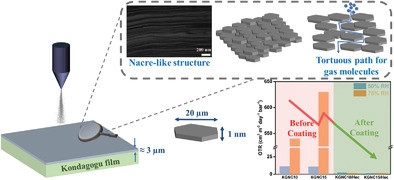News
High Barrier, Biodegradable Nanocomposite Films Based on Clay-Coated and Chemically Modified Gum Kondagogu
25.02.2022
Abhilash Venkateshaiah, Renee L. Timmins, Elmar Sehl, Stanislaw Waclawek, Miroslav ?Cerník, Vinod V. T. Padil and Seema Agarwal
Macromol. Mater. Eng., 2022, 2200008, DOI: 10.1002/mame.202200008
Lately, environmentally benign packaging materials with biodegradability, flexibility, and high barrier properties are sought after as a substitute for conventional plastic packaging materials due to increasing plastic pollution and microplastics in the environment. Although natural polymers can be sustainable alternatives to petro-sourced, non-biodegradable plastics, they suffer from the poor barrier and mechanical properties. In this study, a mechanically stable, biodegradable film of tree gum kondagogu with remarkable barrier properties is fabricated. The introduction of spray-coated, waterborne, large-aspect ratio sodium-hectorite dispersion on tree-gum films ensured very high barrier properties even at high relative humidity conditions (oxygen transmission rate (OTR) ˜1.7 cm3 m-2 day-1 bar-1 at 75% relative humidity). The coating not only decreases gas permeability through the films but also minimizes the sensitivity of performance to humidity levels. The clay-coated nanocomposite films outperformed various commercial polymers and are comparable to high-performance packaging films in terms of oxygen barrier properties. Further, the coating improved the mechanical properties of the films rendering them a prospective packaging material. These biodegradable, high-barrier and mechanically robust films are a promising advance in the field of sustainable packaging.


